Bananas
Banana duct-taped to wall
Artist Maurizio Cattelan’s latest piece, consisting of a banana duct-taped to a wall, sold recently for $120,000.Gallery owner Emmanuel Perrotin defended the work by saying, “It looks like a joke, but step back and look at it again, and it becomes so much more.”
The new owner will receive a certificate of authenticity. However, they’ll also be expected to periodically replace the banana (and presumably the duct tape also). Which begs the question: what did they actually buy? The idea of a banana duct-taped to a wall, apparently.
I'm curious to know how long the owner will actually bother to replace the banana. Twenty years from now, will they still be replacing it every few days?
More info: artsy.net
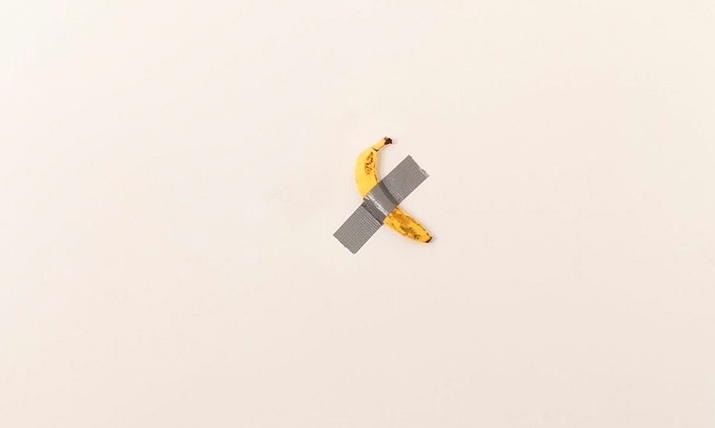
Posted By: Alex - Sat Dec 07, 2019 -
Comments (8)
Category: Art, Overpriced Merchandise, Bananas
Banana Candle
From the Australian Food History Timeline:

Apparently the Banana Candle has a bit of a cult following. YouTube offers modern-day attempts to create and sample it.
Posted By: Alex - Wed May 29, 2019 -
Comments (2)
Category: Food, 1970s, Bananas
Adelaide, the hen who laid banana-shaped eggs
Adelaide the Hen (aka Adelaide Benteggs) lived on the farm of Wilfred Waterman in Poole, England. She first came to the attention of the press in 1957, when she began laying banana-shaped eggs. Farmer Waterman put her in solitary confinement, worried that whatever was causing her to lay such eggs "might be catching."Experts from the British Ministry of Agriculture subsequently x-rayed and otherwise examined Adelaide, but couldn't find anything obviously wrong with her that was causing her to lay the banana-shaped eggs.
Adelaide, however, kept laying the odd eggs — hundreds of them — and as a result became a celebrity hen. She appeared on TV and helped raise over £1000 for charity.
When she died, on August 11, 1961, it made international news. It was reported that she died quietly, sitting on her nest, after laying another curved egg. Officials from the British Museum expressed an interest in performing an autopsy on her, but before they could do so Farmer Waterman had her cremated. He kept the ashes in an urn on his sideboard.
Despite her fame, I've been unable to find a single picture anywhere of either Adelaide or one of her curved eggs, which I find puzzling. I would have thought that press photographers would have loved to document such an oddity.
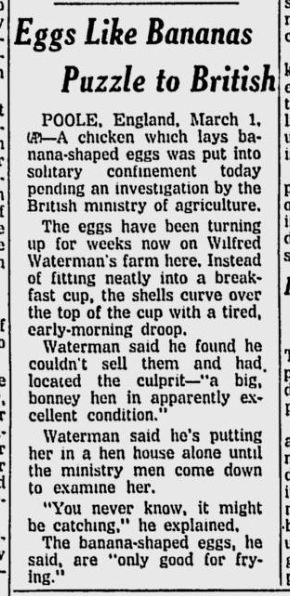
Spokane Daily Chronicle - Mar 1, 1957
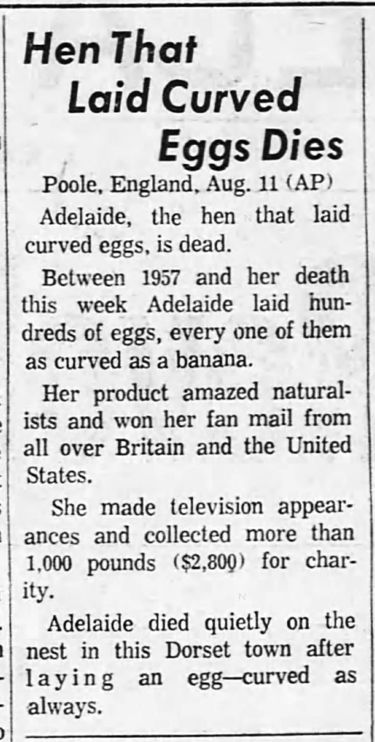
The Decatur Herald - Aug 12, 1961
Posted By: Alex - Sun Jul 17, 2016 -
Comments (0)
Category: Animals, Eggs, 1950s, Bananas
Chiquita Banana Olympics Stickers: 1980
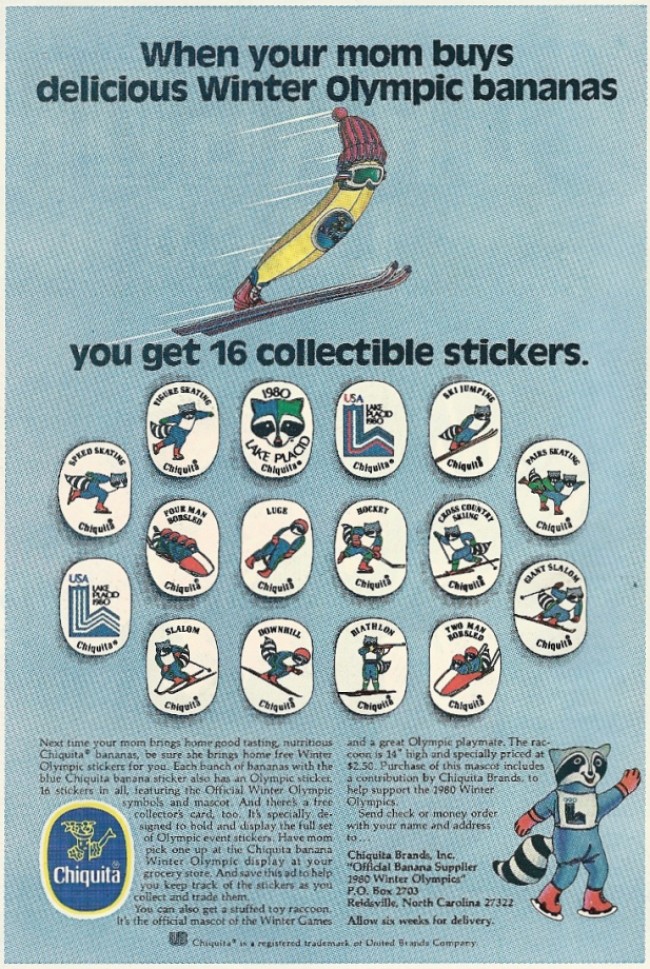
The Brazilian Olympics are in big trouble, as recent news articles tell us. Surely they could use a boost from an athletic banana, like the ad campaign from Chiquita that the 1980 Winter Olympics got. And a tropical fruit is even more synonymous with Brazil than it was with Lake Placid.
Time to bring back Carmen Miranda!
Posted By: Paul - Sun Jul 17, 2016 -
Comments (3)
Category: Disasters, Food, Sports, 1980s, North America, South America, Bananas
People who have slipped on banana peels
I came across a 1927 case of a cliche come to life — a thief fleeing on foot who was caught because he accidentally slipped on a banana peel, which sent him sprawling.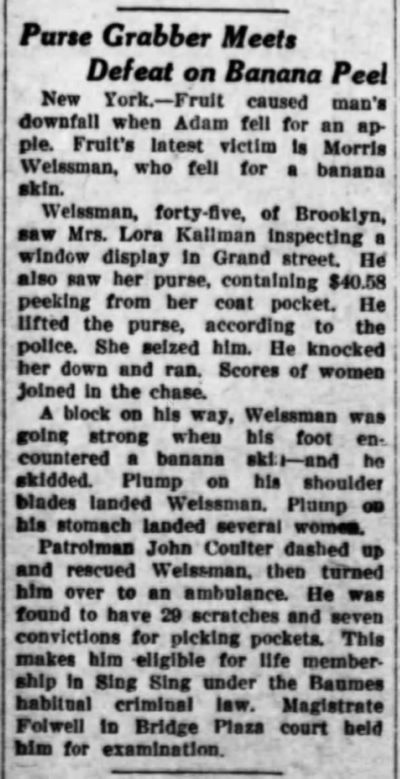
New Cambria Leader - Nov 11, 1927
I figured that Chuck must have documented cases of people who have slipped on banana peels, and sure enough he has.
• 2011 — Ida Valentine, who filed a lawsuit against a California 99 Cents Only store after slipping on a banana peel and suffering a herniated disk. (posted here on WU)
• 2007 — Joyce Walker, awarded $4,110 for injuring her knee in a hospital restroom after slipping on a banana peel. (newsoftheweird.com)
• 2001 — Dorothy M. Ellis Williams, who sued a Quiktrip gas station after she slipped on a banana peel on the pavement outside their store and injured her back and knee. (google groups)
MythBusters has investigated whether you can really slip on a banana peel, and they concluded that although it's not as easy to do as the cliche might suggest, it's definitely possible. Older skins are more slippery. They also note that the cliche originated in the early 20th century after bananas first became a popular fruit, which led to numerous old skins littering sidewalks, and therefore numerous accidents.
Also, back in March 2016 it briefly became a fad among teenagers to take videos of themselves slipping on banana peels and then post the videos online. It was called the "banana peel challenge" #bananapeelchallenge. (Daily Mail)
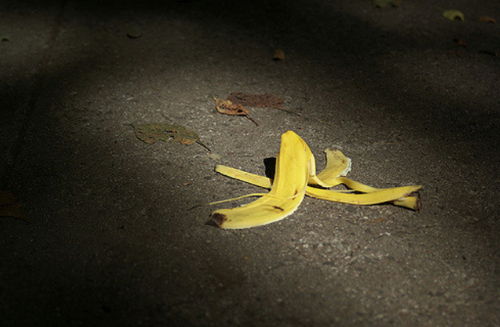
Photo by Sandman_KK (via Flickr)
Posted By: Alex - Sun Jul 03, 2016 -
Comments (5)
Category: Accidents, 1920s, Bananas
Banana and Mayonnaise Sandwiches

There's a Facebook community dedicated to Banana and Mayonnaise Sandwiches. Also, this is apparently one of Dale Earnhardt Jr.'s favorite foods.
The Garden & Gun blog traces the popularity of peanut butter and mayo sandwiches (and presumably also of banana and mayo) back to the Great Depression:
Newspaper clippings from the national heyday of the peanut butter and mayonnaise sandwich, a period that seems to have begun in the 1930s and continued through the 1960s, provide evidence that the practice of adding mayonnaise to peanut butter could have originated as a way of transforming rough-hewn nut butters into spreadable pastes.
Posted By: Alex - Wed Jul 22, 2015 -
Comments (14)
Category: Food, Mayonnaise, Bananas
Scratch-n-Sniff Banana Wallpaper
You can get a roll of it for $470. And it really will smell like bananas if you scratch it.
Posted By: Alex - Thu Mar 19, 2015 -
Comments (7)
Category: Products, Bananas
Wearable Banana
Dole Japan has developed what they call the "wearable banana" to be worn by marathon runners. BakeryAndSnacks.com explains:People have noticed the similarity (at least in name) between the 'wearable banana' and the 'wearable tomato project' (which I posted about last week). Is the one a rip-off of the other? Or is the similarity just an example of a simultaneous discovery of the concept of wearable fruit?
Posted By: Alex - Mon Mar 02, 2015 -
Comments (3)
Category: Food, Sports, Bananas
Sexy Banana Spokeslady
This is really four commercials back to back. I like that sentient bananas are willing to strip their skins off and sacrifice themselves for humans.
Number three has one of the typical vintage representations of a cannibal for you to marvel at.
Posted By: Paul - Sat Jan 10, 2015 -
Comments (9)
Category: Food, Stereotypes and Cliches, Advertising, 1940s, Bananas
Banana-Launched Ship
On January 23, 1941, in Beaumont, Texas, the Cape Lookout cargo ship was launched using three-and-a-half tons of "well-ripened bananas" in order to lubricate its slide into the water. It wasn't the first time a ship had ever been launched using bananas, but at the time it was definitely the largest ship ever launched by this method. Does it still hold this record? I have no idea. The reason bananas were used was because, at the time, they were cheaper than grease.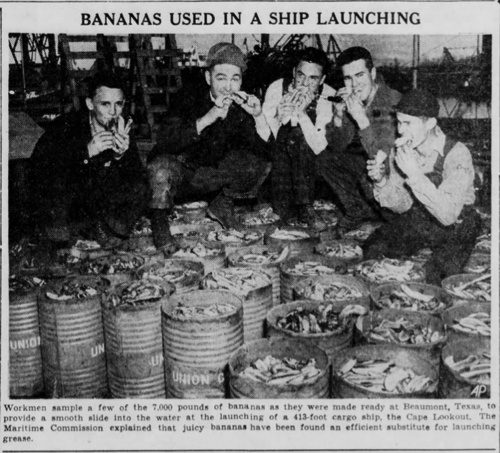
Corsicana Semi-Weekly Light (Corsicana, Texas) - Jan 28, 1941
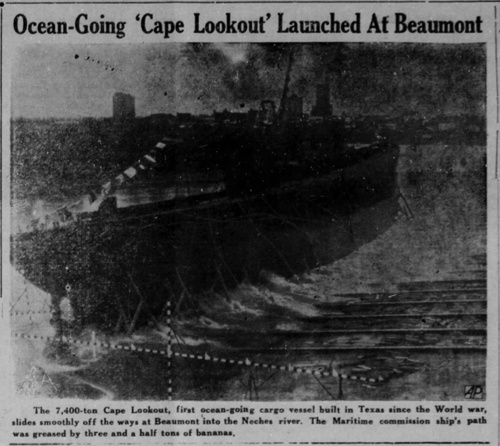
The Eagle (Bryan, Texas) - Jan 28, 1941
Posted By: Alex - Thu Jun 19, 2014 -
Comments (11)
Category: 1940s, Bananas

| Who We Are |
|---|
| Alex Boese Alex is the creator and curator of the Museum of Hoaxes. He's also the author of various weird, non-fiction, science-themed books such as Elephants on Acid and Psychedelic Apes. Paul Di Filippo Paul has been paid to put weird ideas into fictional form for over thirty years, in his career as a noted science fiction writer. He has recently begun blogging on many curious topics with three fellow writers at The Inferior 4+1. Contact Us |




